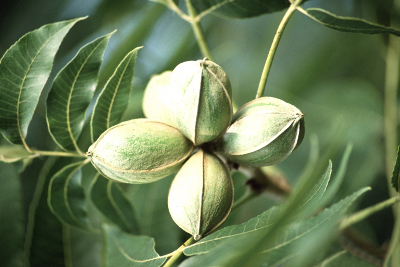Pecan Tree (Carya illinoinensis)
Category: Fruit & Nut Trees

The Pecan tree can grow well in both urban and rural environments. The astonishing thing about this tree is that it doesn’t produce a tree identical to its parent. The most interesting fact is that each tree seedling produces nuts with variable quality. When you want to propagate a pecan tree of a particular cultivar, shoots or buds from the parent tree must be grafted onto the seedling rootstock. Normally, the open grown pecan trees are characterized by huge trunks and oval wide spreading crowns of branches that extend downwards the trunk while their forest counterparts exhibit straight trunks and pyramidal, compact crowns. They begin producing nuts after about 6 years of planting and it continues to bear throughout its lifetime
Attributes
This is one of the America’s top nut producer. They are widely grown in Texas and Georgia. Pecan’s nuts are nutritious and sweet. It can be used as a hard, beautiful wood tree highly valued for its furniture and hardwood flooring. Besides being a beautiful shade tree, it has other valuable uses. The tree is usually difficult to transplant because of the long tap root it develops. Multiple trees should be planted to ensure pollination.
Conditions For Growth
In open settings, the Pecans have slow to moderate growth. Pecan trees usually grow well in sunny conditions and they should be planted in well-drained, moist and loamy soils. They can do well in soil PH between 4.5 and 7.5. They can also do well in alkaline soils of New Mexico and Arizona though additional fertilization may be required.
Leaves, Shape And Height
Pecan trees exhibit light brown to grayish-brown barks that have scaly ridges separated by narrow fissures. They have compound leaves that range from 12 to 20 inches in length. The number of leaflets for every leaf ranges from 9 to 17 but it will always be an odd number. They are sharply pointed at the tip and they are featured by sharply toothed margins. The Pecan nuts form in clusters of 3 to 12. Pecan nuts are well-contained in the dark-brown, thin-shelled husks.

 Back To Category Fruit & Nut Trees
Back To Category Fruit & Nut Trees